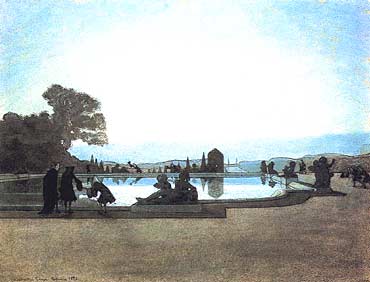 Alexander Benois (1870-1960) Alexander Benois (1870-1960)
Russian painter and stage designer Alexander Benois was born in a family of a St. Petersburg architect. He grew up in an atmosphere of love and respect for the arts. One of his brothers was also an architect and the other an excellent water-colorist. In 1894 Benois received a law degree from the St. Petersburg University and from 1896 till 1899 lived in France. There, he became fascinated with the life of Versailles and the epoch of Louis the XIV. Researching the period, Benois discovered the memoirs of the Count Louis de Saint-Simon, an eyewitness of the Sun-King's last years. Later, he used the memoirs for a series of paintings about life in the Versailles.
Chinese Pavillion: The Jealous One, painted in 1906, is related to the Versailles series. The actions of the characters are simplified until they acquire the schematic nature of the Italian commedia dell' arte. Placing the Chinese Pavillion in the centre of the painting, Benois elevates it to the status of the main "hero" of his work. One of Benois' favorite artistic devices, the impression that the human figures are just puppets, "governed" by majestic architecture, in this work is strengthened by the fact that the pavillion resembles a precious toy and dominates the composition, which corresponds to the World of Art notion that theater is first of all a spectacle, a "feast for the eyes." Benois conjures a precious "object d'art," in which the turquise sky with myriads of stars, the mysterious glow of the lights of the pavillion, and the doll-like tiny figures make us feel that we are looking at a delicate toy, perhaps at an elaborate music box. d'art," in which the turquise sky with myriads of stars, the mysterious glow of the lights of the pavillion, and the doll-like tiny figures make us feel that we are looking at a delicate toy, perhaps at an elaborate music box.
After returning to St. Petersburg, Benois admitted that "no Versailles could compare with impressions made by Peterhof and Pavlovsk." As if he wanted to prove his point, he published highly acclaimed illustrations to Pushkin's Bronze Horseman and The Queen of Spades. Nevertheless, as before, the "heroes" of his illustrations are not the people but their surroundings, the landscape, the atmosphere and the spirit of the city.
One of the founders of the World of Art group, Benois, like many of his colleagues, refused to search for beauty in the chaos of contemporary life, and turned entirely to the past, producing series of paintings devoted to Elizabeth Petrovna and Catherine the Great. The World of Art circle was responsible for the revival of Russian book illustration, astonishing theatrical productions, rekindling of interest in the beauty of St. Petersburg, and the study of Russian art of the eighteenth and the nineteenth century.
Benois' international fame rests on his stage designs; he fused in them the traditional Russian folk elements with the French Rococo style. Theatrical spect acle for Benois was a fanciful invention, a stage magic, and a mirage. He assumed the role of a "theatrical wizard" who offered the viewers brilliant but purely fantastic images. He collaborated with Serge Diaghilev both in Russia and in Paris on a number of ballets, Giselle, Le Pavillon d'Armide, Les Sylphides, and Petrushka (1909-11), for which he wrote the libretto and made designs. The critics admitted that despite the "florid and wildly varied colors of the stage decorations and costumes, during the performance of Petrushka they could feel a deeply Russian harmony, a mixture of naive barbarism and refinement". Benois also collaborated with the Moscow Art Theater (MKhAT), where he directed and designed plays by Moliere, Goldoni, and Pushkin. acle for Benois was a fanciful invention, a stage magic, and a mirage. He assumed the role of a "theatrical wizard" who offered the viewers brilliant but purely fantastic images. He collaborated with Serge Diaghilev both in Russia and in Paris on a number of ballets, Giselle, Le Pavillon d'Armide, Les Sylphides, and Petrushka (1909-11), for which he wrote the libretto and made designs. The critics admitted that despite the "florid and wildly varied colors of the stage decorations and costumes, during the performance of Petrushka they could feel a deeply Russian harmony, a mixture of naive barbarism and refinement". Benois also collaborated with the Moscow Art Theater (MKhAT), where he directed and designed plays by Moliere, Goldoni, and Pushkin.
Benois published portfolios of art treasures of Russia and a History of Russian Painting (1904). After the Revolution, he was made curator of the painting at the Hermitage. In 1926 he left Russia and settled in Paris where he spent the rest of his life, involved in staging about 200 operas and ballets in many cities of Europe and America.
|













 Culture and Art
Culture and Art  Painting
Painting  XX century
XX century